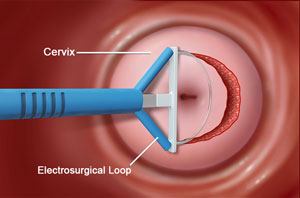What is loop diathermy excision (LLETZ)?
Loop diathermy excision is a method of treatment used to remove the abnormal cells on the cervix (neck of the womb). Needing this treatment does not mean that you have cancer, however, it does mean that the cells are showing some abnormal change that, if left, could turn into cancer in the future; thus it is an effective way of preventing cervical cancer. This technique uses an electrically heated fine wire loop to remove the abnormal cells from the cervix and the wound is then cauterised, leaving a small burn. The piece of tissue which has been removed will then be sent to the laboratory to check that all the abnormal cells have been removed. The treatment could be performed either as an outpatient procedure, under local anaesthetic and takes about 10 minutes or if you prefer this could also be performed under general anaesthesia.
You may wish to take mild pain relief prior to treatment to help with any potential discomfort. You may experience stinging/discomfort while the local anaesthetic is injected into your cervix, which lasts only for a short time until the local anaesthetic takes effect. While the abnormal area is removed you may experience some period cramp-like discomfort.
Why do I need treatment and what are the benefits of treatment?
By performing this procedure, we will be removing the abnormal cells which have been identified. This does not mean that you have cancer, but the cells are showing changes that are pre-cancerous and if left could develop to cancer in years to come. The treatment is 90% effective in removing all the abnormal cells. However it is still important to have regular follow up smears as directed to confirm this.
What exactly happens when I come for treatment?
Treatment is very similar to that of a colposcopy examination. You will have a consultation with your gynaecologist first, and then you will be taken into the examination room. When you are in a comfortable position, your gynaecologist will gently insert a speculum into the vagina, the same as when you have a smear test and will then use the colposcope to examine the cervix, by applying different liquids to help identify and highlight the abnormal areas. Once this has been done the abnormal areas will be numbed using local anaesthetic. Time will be given for the local anaesthetic to work, and then the treatment will be carried out. The treatment can take around 10-15 minutes in total. After the treatment the speculum will be removed and you will be asked to stay on the examination couch for a few minutes to rest.
What will I expect to happen afterwards?
You may experience some or none of the following:
- The procedure should not be painful but may cause some mild discomfort similar to period-type pain / cramps. Paracetamol or ibuprofen should relieve any discomfort you may experience after the procedure.
- You may experience a red / brown discharge for a period of time. It could be a few days to four weeks following the treatment. You may also notice a few black particles which are normal, resulting from the diathermy used during the treatment. Everyone heals differently, and some women may experience discharge for longer than others.
- There may be a temporary change in your menstrual cycle after treatment.
- Rest for the remainder of the day. Bath or shower as normal but do not attempt to douche inside the vagina, and avoid using perfumed products.
- Use sanitary pads for four weeks, not tampons; this will help to reduce the risk of infection and allow the cervix to heal.
- Αvoid intercourse for four weeks; this will help to reduce the risk of infection and allow the cervix to heal.
- Avoid swimming for two weeks or until the bleeding / discharge has stopped. Other normal activities, including light exercise, may continue
What about getting pregnant?
Treatment will not affect your future fertility and will not increase the risk of miscarriage. However, there is a slightly increased risk of premature labour in women who have had a loop excision, which is approximately 3% compared to 1% in the general population. Women who have undergone two or more loop excisions will usually be seen in pregnancy by their obstetrician to assess the risk of premature labour for cervical length scans. It is advisable to wait until you have had your treatment before trying to conceive as treatment cannot be carried out if you are pregnant. We recommend that you have a negative smear six months after treatment before trying to conceive.




